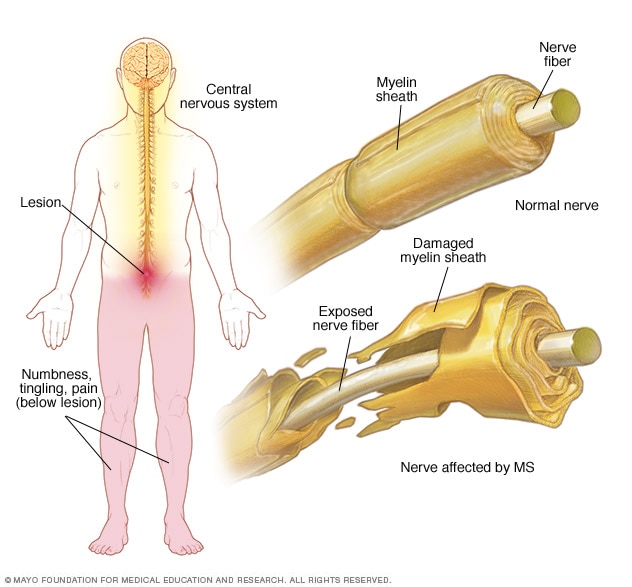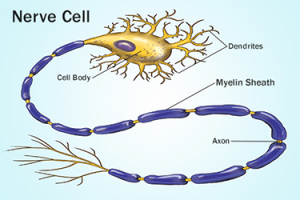 Multiple Sclerosis is a chronic autoimmune disorder with devastating long term implications on all who those who experience it. Averaging roughly 2.5 million cases throughout the world, MS is the predominant cause of disability in younger individuals, with the typical age of onset being between the ages of 20-40 (Naseer, et al, 2020). Despite the skyrocketing rates of diagnosis, MS can be a difficult condition to pinpoint due to it’s vastly different array of symptoms and irregular presentation. As such, a thorough look into the core of what MS is and how to manage the condition could provide tremendous help to those experiencing the condition (either personally or through loved ones).
Multiple Sclerosis is a chronic autoimmune disorder with devastating long term implications on all who those who experience it. Averaging roughly 2.5 million cases throughout the world, MS is the predominant cause of disability in younger individuals, with the typical age of onset being between the ages of 20-40 (Naseer, et al, 2020). Despite the skyrocketing rates of diagnosis, MS can be a difficult condition to pinpoint due to it’s vastly different array of symptoms and irregular presentation. As such, a thorough look into the core of what MS is and how to manage the condition could provide tremendous help to those experiencing the condition (either personally or through loved ones).
Firstly, when discussing Multiple Sclerosis, it’s necessary to analyze what exactly is happening within the body that causes the disorder to occur. As a point of comparison, let’s think of Coronary Artery Disease, a condition which is characterized as an accumulation of various substances (fat and cholesterol, for example) within the inner lining of the arteries. This becomes a problem because the heart essentially uses the arteries as a means of “communicating” with other organs in the body. The heart pumps oxygen rich blood through the arteries toward the other organs of the body as is necessary for them to function. Coronary Artery Disease causes the buildup of fat, cholesterol, and lipoproteins builds within the arteries, (otherwise known as causing “sclerosis”, or hardening of the inner arterial vessels). This blocks communication between the heart and other organs, causing those organs to not receive the necessary oxygen. This causes what is known as an infarction, which occurs when an organ begins to decay from lack of oxygenation. (Ghasemi, et al, 2015).
Multiple Sclerosis has a similar process within the bodies central nervous system with a few key differences. Instead of blood vessels or arteries, MS effects a series of nerve cells that deliver nerve impulses from one another as a means of communicating between the brain and the rest of the central nervous system. The time between the brain deciding on an action (i.e, having a person move their right foot forward to walk) and communicating that action throughout the nervous system to make it happen is generally instantaneous. MS causes that similar block in communication to occur within the nerve cells or the “myelin sheath” (which is essentially the vehicle through which nerve impulses move from one cell to another), causing these rapid impulses to process at a much slower rate, or depending on the state of the condition, not at all. However, instead of fat or cholesterol, this happens because of the bodies immune system. The immune system’s role in the body is to recognize any potential dangerous particles (bacteria, viruses, etc.) that may have entered the body and destroy it before it causes damage. However, with an autoimmune condition, the immune system mistakenly believes that this dangerous particle is present in the body even when it isn’t. The body automatically attacks otherwise healthy tissue, and in this case, the bodies nerve cells. These attacks produce inflammation and scar tissue that cause a similar blockage between nerve cells (Polisetty & Padi, 2020).
This is why symptoms of MS are so varied. The condition is named “Multiple Sclerosis” because it is caused by these multiple blockages (or “sclerotic” plaque accumulations within the nerve pathways) that can occur anywhere within the central nervous system. As such, the symptoms that patients present with varies based on where the blockages happen to occur. These symptoms can range from vision loss, difficulty walking, numbness, fatigue, paralysis (Polisetty & Padi, 2020), urinary tract dysfunction (Philippova, et al, 2020), speech impediment, impaired swallowing (Farazi, et al, 2019), and cognitive impairments such as decreased information processing speed, loss of memory, and depression (Naseer, et al, 2020). During early stages of the disease, symptoms present in a cycle or relapse and remission, where patients can have no symptoms for some periods of time and several symptoms for other periods of time. As the disease progresses, it can cause gradual and irreversible damage to the CNS in untreated patients, causing the symptoms to occur on a more constant basis (Naseer, et al, 2020).
While there is technically no cure for Multiple Sclerosis, though there is a frequently mentioned necessity for early diagnosis and monitoring as a means of preventing progression. MRI scanning of the CNS is the usual means of diagnosis, and prescription of some disease-modifying medications (such as Copaxone, Novanstrone, and Avonex), which, while not proven to alleviate some of the chronic neurological deficits, have shown great progress at decreasing the rate of symptom progression. (Alshammari, et al, 2019).
For additional information:
References
Alshammari, Y. H. M., Aldoghmi, A. K. B., Al Afif, H. S. A., Alfayi, B. A., Alrebh, A. H., Alsayafi, Z. A., Fatani, Y. A., Aldughmi, A. N., Alzaidan, A. M., Alsubaiei, S. A. O., & Alqethami, S. S. (2019). Multiple Sclerosis Diagnosis and Management: A simple Literature Review. Archives of Pharmacy Practice, 10(4), 33–37.
Farazi, M., Ilkhani, Z., Jaferi, S., & Haghighi, M. (2019). Rehabilitation Strategies of Dysphagia in a Patient with Multiple Sclerosis: A Case Study. Zahedan Journal of Research in Medical Sciences, 21(2), 1–4. https://doi.org/10.5812/zjrms.85773
Ghasemi, R., Dastani, M., Abdolahi, A., & Rahimi, H. R. (2015). Peripheral arterial stenosis and coronary artery disease coincidence. Reviews in Clinical Medicine, 2(1), 5–8.
Naseer, M. A., Fathi, S., Labib, D. M., Khalil, D. H., Aboulfotooh, A. M., & Magdy, R. (2020). Early detection of cognitive dysfunction in patients with multiple sclerosis: Implications on outcome. Brain Impairment, 21(2), 208–216. https://doi.org/10.1017/BrImp.2019.26
Philippova, E. S., Bazhenov, I. V., Ziryanov, A. V., & Moskvina, E. Y. (2020). Evaluation of Lower Urinary Tract Dysfunction Impact on Quality of Life in Multiple Sclerosis Patients: Russian Translation and Validation of SF-Qualiveen. Multiple Sclerosis International, 1–5. https://doi.org/10.1155/2020/4652439
Polisetty, K., & Padi, T. R. (2020). Optimality quality control thresholds for effective management of multiple sclerosis. Songklanakarin Journal of Science & Technology, 42(5), 1059–1064.

Mathew, this blog post was a very interesting read. I like how you compared multiple sclerosis to the stenosis of the heart vessels in coronary artery disease. The parallel helped to form a picture in my head, that the signals from the brain to the rest of the body are being blocked, just like how bloodflow is blocked in coronary artery disease. This was a great article!